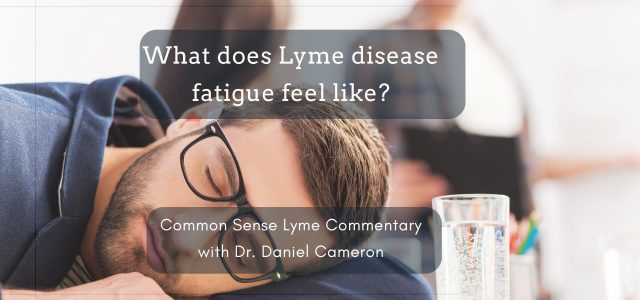
Lyme disease fatigue is one of the most common—and most frustrating—symptoms of the illness. It’s not just “feeling tired.” Many of my patients describe it as bone-deep exhaustion. Some say it feels like moving through wet cement. Others say they wake up feeling just as drained as when they went to bed.
For some, the fatigue caused by Lyme disease develops early, during acute infection. Others don’t feel it until months later. Regardless of timing, it can be debilitating.
What does Lyme disease Fatigue feel like?
-
- Extreme exhaustion — even after rest or sleep
- Sudden energy crashes (you feel okay one moment, then can’t get out of bed the next)
- Mentally draining — like brain fog, poor focus, and memory lapses
- Worse after physical or mental exertion (called post-exertional malaise)
- Unrefreshing sleep — you sleep long hours but still wake up exhausted
- Weakness or heaviness in limbs, like moving through quicksand
What causes Lyme fatigue?
Several factors likely contribute to Lyme-related fatigue. These include:
Ongoing Immune Response
The body’s inflammatory response to Borrelia burgdorferi and other tick-borne pathogens may create a persistent sense of malaise.
Persistent infection or co-infections
Ongoing fatigue may reflect an untreated or undertreated tick-borne infection. In my practice, in addition to Lyme disease, I’ve seen Babesia, Bartonella, and even Anaplasma contribute to long-term fatigue.
Neuroinflammation
Inflammation in the brain or central nervous system.
Sleep disruption
Pain, night sweats, anxiety, and neurological symptoms can interfere with restful sleep—worsening fatigue over time.
Autonomic dysfunction (like POTS)
Many Lyme patients experience dysautonomia, which affects circulation, blood pressure, and energy regulation. These patients may feel lightheaded, flushed, or exhausted after standing—hallmarks of postural orthostatic tachycardia syndrome (POTS).
Post-exertional malaise (PEM)
PEM occurs when even small amounts of physical or mental effort trigger a worsening of symptoms. This is seen in chronic Lyme, ME/CFS, and Long COVID. The fatigue may not show up immediately—it might worsen 12–24 hours after activity.
When Does It Happen?
Fatigue caused by Lyme disease can show up in early Lyme – within days to weeks after infection. Or it can present in late-stage Lyme. The fatigue can last for months or years if the infection is left untreated or under-treated.
Lyme disease fatigue – chronic Lyme or PTLDS?
When fatigue persists after a standard course of antibiotics, some patients are told they have chronic Lyme disease or late-stage Lyme. Others receive the label of Post-Treatment Lyme Disease Syndrome (PTLDS).
The terminology remains controversial, but the experience is real. Some PTLDS cases may reflect lingering inflammation. Others may involve persistent infection.
This result is sometimes dismissed, but in clinical settings—especially when patients present with hallmark symptoms—it may raise concern for continued infection and merit further evaluation.
Conditions That May Improve With Tick-Borne Illness Treatment
Fatigue is not unique to Lyme disease. It is also seen in other conditions such as:
-
-
Myalgic Encephalomyelitis/Chronic Fatigue Syndrome (ME/CFS)
-
Long COVID
-
Fibromyalgia
-
POTS and autonomic dysfunction
-
Depression or anxiety disorders
-
Autoimmune diseases like Lupus or Sjögren’s
-
But here’s what I’ve found in practice:
Some patients struggling with these diagnoses have improved significantly after treatment for a tick-borne illness. When their history includes tick exposure, rashes, migrating pain, or night sweats, I keep Lyme disease—and its co-infections—on the radar.
Movement vs. Rest in Lyme Disease Fatigue Recovery
You’ve probably heard “rest, rest, rest” if you’re dealing with Lyme disease fatigue. But in my clinical experience, too much rest can sometimes make patients feel worse—more isolated, achy, and discouraged.
Extended inactivity can lead to:
- Deconditioning
- Disrupted sleep
- Increased pain sensitivity
- Loss of motivation
Instead, I encourage patients to balance strategic rest with gentle movement. That might mean:
-
-
Stretching
-
Walking for 1–5 minutes
-
Reclined yoga or deep breathing
-
Physical therapy tailored to energy levels
-
The goal isn’t to push through. It’s to move just enough to support healing—without triggering post-exertional crashes.
“Movement reminds the body what healing looks like—even if it’s just a few minutes a day.”
Supporting Autonomic Function in Lyme disease fatigue
Autonomic symptoms can sap energy. In my practice, I help patients manage this using:
-
-
Hydration – Electrolyte-rich fluids can help improve blood volume.
-
Salt – Increasing salt intake can help some patients with low blood pressure or POTS.
-
Pacing – Planning activities in manageable chunks helps prevent overexertion.
-
Compression garments – Can reduce pooling of blood in the legs.
-
Every patient is different, but managing the autonomic nervous system is often a key piece of the puzzle.
Final Thoughts: Lyme Disease Fatigue Deserves Serious Attention
Lyme-related fatigue is not just in your head—and it’s not always resolved with short-term treatment.
If you’re experiencing overwhelming exhaustion, brain fog, or post-exertional crashes, don’t assume it’s “just aging” or stress. Lyme disease and co-infections are worth considering—especially if there’s any history of tick exposure.
Treatment can take time. But many of my patients improve once the root cause is identified—and addressed.
References
-
CDC – Signs and Symptoms of Lyme Disease
https://www.cdc.gov/lyme/signs-symptoms/index.html
Fatigue is listed as a common symptom in both early and late Lyme disease. -
NIH / NIAID – Post‑Treatment Lyme Disease Syndrome (PTLDS)
https://www.niaid.nih.gov/diseases-conditions/post-treatment-lyme-disease-syndrome
Explains PTLDS, including persistent fatigue, and ongoing research into immune mechanisms. -
Emerging Infectious Diseases – Interferon-alpha and Fatigue in Neuroborreliosis
https://www.ncbi.nlm.nih.gov/pmc/articles/PMC10202885/
Findings suggest elevated IFN-α may explain ongoing fatigue after treatment. -
BMC Infectious Diseases – Fatigue in Lyme Borreliosis
https://bmcinfectdis.biomedcentral.com/articles/10.1186/s12879-022-07686-8
Documents that fatigue often persists even after early antibiotic treatment. -
DanielCameronMD.com – Fatigue Can Be an Overlooked Sign of Lyme Disease
https://danielcameronmd.com/fatigue-can-overlooked-sign-lyme-disease/
Discusses how fatigue may be dismissed or misdiagnosed, and why further evaluation may be needed. -
DanielCameronMD.com – What Does a Lyme Flare‑Up Feel Like?
https://danielcameronmd.com/what-does-a-lyme-flare-up-feel-like/
Highlights fatigue as a key feature of flare-ups and ongoing illness.



Everything stated in this report is what I am experiencing. I also do everything that is recommended by you to challenge my Lyme, but just want to know how long this will last, as I am in my 4th month since being diagnosed.
Thank you.
Rose Marie
Every patient is different. I also use the time to rule out other illnesses
What about bone-crushing fatigue that shows up 2-3 months after the bite? The site of the bite is still raised. It sometimes itches and I get headaches in that area. I have to occasionally reach for words. I don’t seem to have other Lyme symptoms. The bite is in my scalp, so I would not have noticed any rash around the bite. My doctor did test for Lyme about 7-10 days after the bite, but I don’t know which test she used.